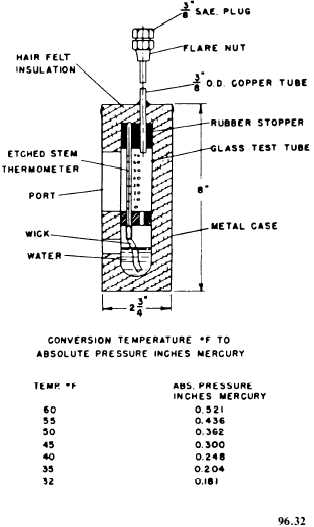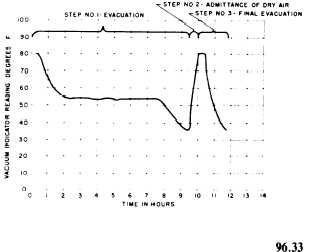When H2O combines with R- 12 it forms sulfric
acid which will attack the entire system. Good
engineering practice dictates that evacuation,
dehydration and fixing all air leaks will in the long
term prevent an acid attack upon the system.
evacuation process. If possible, the dehydrated
air should be heated to about 240°F.
Large dehydrators, suitable for preliminary
dehydration of refrigeration systems, are usually
available at naval shipyards and aboard tenders
and repair ships.
Where moisture accumulation must be cor-
rected, the system should first be cleared of
refrigerant and air. The time required for these
processes will depend upon the size of the system
and the amount of moisture present. It is good
engineering practice to circulate heated air
through a large dehydrator for several hours,
or as long as the dehydrator drying agent
remains effective, before proceeding with the
After the preliminary dehydration, the remain-
ing moisture is evacuated by means of a two-stage
high-efficiency vacuum pump. (These vacuum
pumps are available aboard tenders and repair
ships.)
A vacuum indicator (figure 6-9) is attached to
the two-stage high efficiency pump. It consists of
an insulated test tube containing a wet bulb ther-
mometer with its wick immersed in distilled water.
This indicator is connected to the vacuum pump
suction line, which in turn, is connected to the
refrigeration system. The refrigerant circuit should
be closed to the atmosphere and the charging con-
nection should be opened to the vacuum pump.
Two-stage pumps are started for operation in
PARALLEL so that maximum displacement may
be obtained during the initial pump-down stages.
When the indicator shows a temperature of about
55 °F (0.43 inch Hg, absolute), the pumps are
placed in SERIES operation (wherein the
discharge from the first step enters the suction of
the second step pump). The dehydration process
will be reflected in the temperature drop of the
vacuum indicator (as shown in figure 6-10).
Readings will initially reflect ambient
temperatures. Then they will show rapidly
Figure 6-10.—Vacuum indicator readings plotted during
Figure 6-9.—Dehydrator vacuum indicator.
dehydration.
ENGINEMAN 1 & C
6-14



